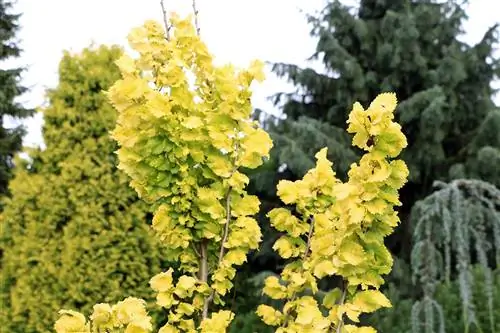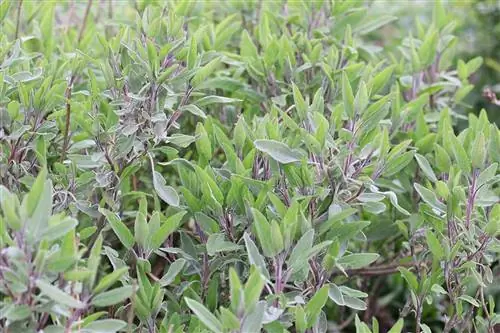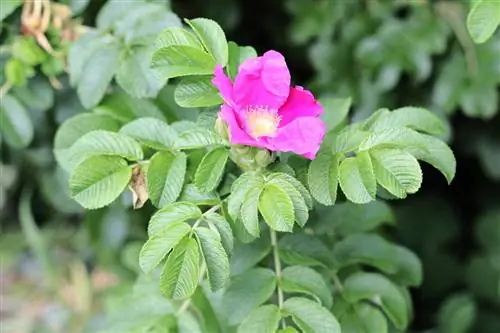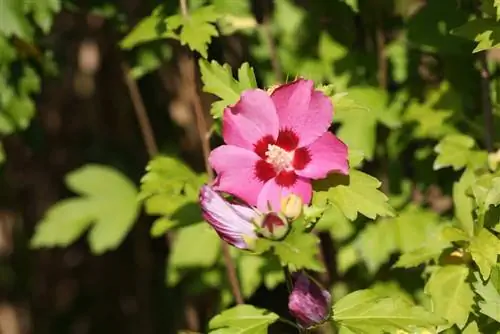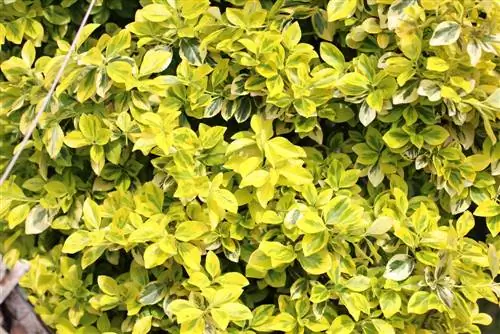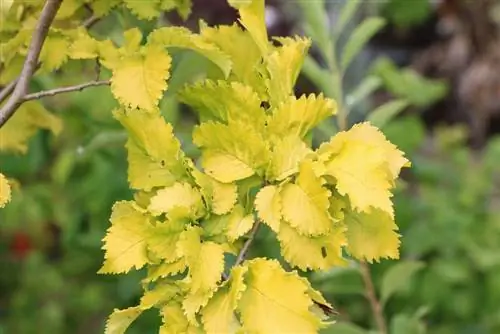- Author admin [email protected].
- Public 2023-12-17 03:39.
- Last modified 2025-01-24 12:45.
The golden elm grows as a large shrub less often than a small tree. Their greatest decoration is the golden yellow leaves when they shoot, rich yellow in summer and rich yellow to delicate green in autumn.
Profile
- Plant family: Elm family (Ulmaceae)
- Botanical name: Ulmus hollandica 'Wredei'
- German name: Golden Elm
- Growth: columnar, tightly upright, slow
- Growth height: 5-10 m
- Leaves: bright golden yellow, twisted, wavy, summer green
- Flower: red-brown flower clusters
- Flowering time: March to April
- Lime tolerance: Lime-loving
- Toxicity: No toxic properties known
Location requirements
The golden elm prefers sunny locations where the golden yellow foliage is particularly effective. But it also thrives in partial shade, best as a solitary tree. If it is too shady, the leaves stay green. As far as the soil is concerned, it should above all be permeable, deep, nutrient-rich, calcareous and not too dry. Substrates that are too firm can be improved by adding gravel or sand. If the soil is too light, mixing in compost or lime helps. It is best to prepare the soil accordingly before planting.
Watering and fertilizing
In the first few weeks after planting and during drought, water should be regular. Once established, the natural amounts of rainfall are usually sufficient, except in long-term heat and drought. In order to supply the elm with all the important nutrients, apply a commercial fertilizer for trees and shrubs or compost in the spring.
To cut or not?
One of the special features of the golden elm 'Wredei' is that it does not need to be cut. As a rule, it grows best if you leave it alone and only use scissors in an emergency. Nevertheless, it is a tree that tolerates pruning and in some cases one or two pruning measures can also make sense. This is the case, for example, if the crown appearance is disturbed by branches and twigs growing inwards or crosswise, or if root runners have formed in an uncontrolled manner and need to be removed.
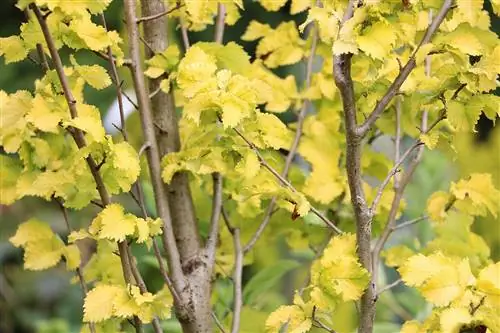
Best time
The best time to prune is in the winter between November and March, the later the better. If it is still relatively warm on the days in question, it is advisable to wait a little longer. Warm temperatures cause scents to escape from the open cut surfaces, which in turn can attract pests. However, if you wait until March to cut, the golden elm will soon sprout again and form many new shoots.
Avoid plant cuttings
If the golden elm has been freshly planted, it should not be trimmed. Pruning at this time would stunt their growth. Specimens purchased from tree nurseries have usually already received the first care and training cuts necessary to build a he althy crown and a straight trunk. Basically, you should give the golden elm enough time after planting to get used to the new location and grow well. As a result, you wait two to three years before the first cut.
Tip:
If in doubt, you should ask when the last cut was made when purchasing.
Strong shaping cut
This attractive tree can also tolerate severe pruning, for example if it has become too large. It can easily be cut back to a height of around three meters. At the same time, some shoots can be cut out of the crown and side shoots shortened.
In addition, it is important to remove both cane and trunk rashes early. In order to disrupt the plant's growth as little as possible, it should be pruned accordingly before it sprouts. However, if you cut more heavily, there is a risk that the plant will lose its natural growth habit or be severely affected.
Tip:
If thicker branches have been removed, it is advisable to then treat the edges of the cuts with a wound closure agent so that the cut heals better. For smaller cuts with frayed edges, it is sufficient to trim them with a sharp knife.
Blending cut
If the crown becomes too dense or wide over time, it can be easily thinned out. It is best to choose a frost-free and overcast day. When pruning, the main thing is to ensure that the crown is well ventilated inside and retains its natural shape.
- cut off wilted, diseased and dead wood, if any
- as well as inwardly growing, crossing and rubbing branches
- cut out all branches that are too close together
- working from the inside out
- cutting into he althy wood possible
- Use pruning at the same time for tree control
Remove root runners
One of the special features of this magnificent elm is that it tends to form runners that sprout from the ground not far from the trunk. Unfortunately, the whole thing is facilitated by pruning, which is the case with all trees that tend to form runners. The elm compensates for the shortening of the above-ground part of the plant by spreading more underground.
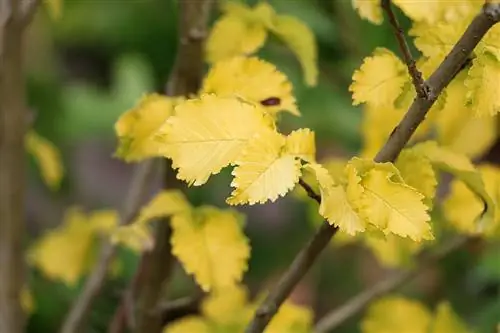
It becomes problematic when the runners penetrate into beds or the lawn and emerge from the ground or lift paving stones on sidewalks. To prevent this, you should remove runners as early as possible. It is not enough to simply pull them out of the ground or cut them off above ground to keep them in check. The whole thing is a little more complicated.
- expose one foothill after the other
- track back to the trunk and dig up the entire shoot
- without damaging the main roots
- all unwanted runners have been removed, root barrier is recommended
- dig to expose the trunk
- at least one meter deep
- Create a root barrier made of special foil
- Fill up the trench with earth again
- Tamp down the soil well and water the elm tree
Tip:
A well-preserved runner can easily be used for propagation if necessary. In order to save yourself the effort with the runners, it is recommended to install a root barrier when planting.
Diseases and pests
Gall mites and elm gall aphid
This elm species is relatively robust against diseases such as the dreaded Dutch elm disease. However, pests such as the elm gall aphid or the gall mite can attack it. They leave so-called poxes on the leaves. Sprays based on rapeseed oil or paraffin from specialist retailers can be used to combat this.

